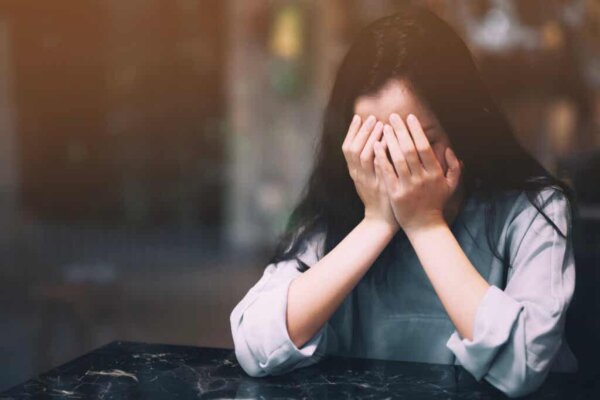Social Anxiety, An Ever-Growing Disorder

A certain level of social anxiety is normal in new situations or those in which you must be the center of attention, such as making a presentation. This is normal and even adaptive, as it prepares you and keeps you from acting on impulse.
In some people, this feeling is more intense when confronting unexpected or frequent events. Thus, they experience a high level of distress when they’re forced to interact with strangers, among others.
In this context, another important point when diagnosing social anxiety (also known as social phobia) is its interference in a person’s daily routine.
“I’m not anti-social. I’m just not social.”
-Woody Allen-
What’s social anxiety?
People with social anxiety have an irrational fear of social situations that aren’t dangerous to their personal integrity. They may exhibit subtle avoidance behaviors, such as sitting in the back of a group activity, not asking questions during a meeting, or apologizing when there’s no reason to do so.
Some population studies indicate that social anxiety is steadily on the rise. It may be because teenagers have fewer and fewer live interactions with their peers in unregulated or scripted environments, such as extracurricular classes, sports, and other activities.
This causes more fragile supportive social environments and they even project deficiencies in certain social skills that are fundamental in adults, especially in the working environment.

There are four important things to consider in order to diagnose a child:
- They’re afraid in social situations that involve peers, not only in the presence of adults.
- Their abilities to relate to family members have always been normal.
- They may not be aware that their fear is irrational.
- Adults have had the symptoms for at least six months.
For Mattick and Clarke, there are two aspects of social phobia: anxiety about social interaction and fears of scrutiny. The term social interaction anxiety refers to the anxiety experienced when meeting and talking to other people, strangers or not.
The differences between social anxiety disorder, avoidant personality disorder, and shyness
The definition of shyness is discomfort and inhibition in the presence of other people. It’s an enduring tendency or predisposition and not simply a reaction to some temporary and specific characteristics. Shyness is the propensity to become anxious in social contexts.
Embarrassment and ridicule are characteristic of social anxiety disorders or social phobia, avoidant personality disorders (AvPD), and shyness. However, there are significant differences between what the two terms represent. Although there are somatic and cognitive similarities, but there are also differences:
- The degree of social and occupational impairment in seasonal affective disorder (SAD) tends to be greater than in those who are shy.
- Shyness tends to have an earlier onset than social anxiety.
- SAD is a chronic condition, whereas shyness may occur earlier in life and then disappear.
- Avoidance tends to be much more tied to SAD than shyness, and the severity of avoidance is much greater in the former than in the latter.
- There’s a fear of rejection and scrutiny in avoidant personality disorder, just as in social anxiety. This avoidance has pretty much been a personality trait since childhood and it’s usually linked to more comorbid problems. Also, there’s a greater difficulty in addressing the problem, since this kind of person avoids a greater number of situations beyond the social ones.
Clinical characteristics of social anxiety disorder
Behavioral characteristics
Individuals with social anxiety disorder fear or avoid situations in which others can see them. There are two prominent behavioral components when it comes to social situations: social skills deficits and avoidance behavior.
They’re quiet, clearly restless, vigilant, and alert most of the time. Thus, they distance themselves from social situations.
Cognitive aspects
A person with social anxiety disorder tends to direct attention to information related to social failure. They display more sensitivity to anxiety than non-clinical control groups. Therefore, this sensitivity may lead them to overestimate the visibility of their anxiety.
Individuals with SAD indulge in negative internal dialogues that divert attention from other cues included in their performance. Perhaps because these individuals perceive both positive and negative aspects of their behavior, but overestimate the degree to which behavioral deficits will impair the overall impression they make on others.
Physiological aspects
People with social phobia may experience palpitations, sweating, tension, nausea, blurred vision, chills, tingling sensations, and paresthesia or numbness. It’s common to find a lump in the throat of socially phobic children. Furthermore, those with SAD seem to be particularly affected by symptoms such as flushing, shivering, and sweating.
Epidemiology and course
The lifetime prevalence of social anxiety disorder is between three to 13 percent. In fact, it’s one of the most common and fastest-growing mental disorders in the world. The United States has the highest prevalence rates. The WHO indicates that it equally affects men and women, although not all studies agree with it.
SAD usually strikes 12-18-year-old teenagers. Its development is usually gradual, but it can also be due to a stressful or humiliating experience. Most people can’t specifically recall the onset when it’s gradual.
Intervention for social anxiety
Cognitive-behavioral psychotherapies are effective in the treatment of social anxiety. The intervention may or may not be linked to a clinical context.
In other words, the person may not meet the diagnostic criteria for social anxiety disorder. However, a therapist can still provide tools to help them reduce tension in potentially stressful situations.
In this context, progressive exposure is one of the most common techniques. The therapist establishes a list of goals to achieve through relaxation and parallel work on the thoughts and emotions of their patient.
The ultimate goal is for the latter to confront their greatest fears without anxiety.

Beyond social awkwardness
Social anxiety may happen naturally in certain situations or may strike a given person at times without interfering with their performance. However, as we explained above, social anxiety disorder goes far beyond the mild social discomfort of partaking in group tasks.
It’s a chronic avoidance of activities because the actual exposure to a group feels like a demand they can’t meet. In fact, the discomfort may manifest as dizziness, numbness, or blocking.
It’s important to recognize the symptoms in teens or young adults as soon as they begin to manifest. Solving a problem in one social area doesn’t mean that social anxiety will cease to interfere in other situations.
For example, one can reach much lower peaks of social anxiety in sports contexts but these will appear in the work environment. It’s usually due to not having worked those aspects related to the anticipation of scrutiny. As you can see, therapy for social anxiety should implement measures aimed at correcting it in all contexts.
This text is provided for informational purposes only and does not replace consultation with a professional. If in doubt, consult your specialist.








